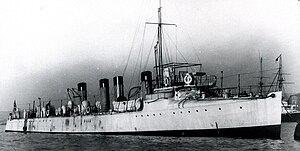
Summary
The Shirakumo-class destroyers (白雲型駆逐艦, Shirakumogata kuchikukan) was a class of two torpedo boat destroyers (TBDs) of the Imperial Japanese Navy, built in Britain in 1901–02.[1]
 Japanese destroyer Shirakumo during commissioning, England, 1902
| |
| Class overview | |
|---|---|
| Name | Shirakumo class |
| Builders | John I. Thornycroft & Company Chiswick, England |
| Operators | |
| Preceded by | Akatsuki class |
| Succeeded by | Harusame class |
| In commission | February 1902 – April 1923 |
| Completed | 2 |
| Retired | 2 |
| General characteristics | |
| Type | Destroyer |
| Displacement | 322 tons normal, 432 tons full load |
| Length |
|
| Beam | 20 ft 9 in (6.32 m) |
| Draught | 8 ft 3 in (2.51 m) |
| Depth | 13 ft 9 in (4.19 m) |
| Propulsion | 2-shaft reciprocating engines, 4 boilers, engine output 7,000 hp (5,200 kW) |
| Speed | 31 knots (57 km/h; 36 mph) |
| Complement | 62 |
| Armament |
|
Background edit
The Shirakumo-class destroyers were ordered under the 1900 fiscal budget as a follow-on to the earlier Murakumo class. Both were ordered on 7 (or 16) November 1900 from the yard of John I. Thornycroft & Company in Chiswick, England.[2]
Design edit
Compared with the previous Murakumo class, the Shirakumo class was significantly larger in displacement with a somewhat more powerful engine. The main difference externally between the vessels was in the design of their rudders. With the previous class, the rudder was semi-balanced, and had a portion exposed above the waterline. This made the vessel vulnerable to disablement by stray gunfire.
The design of the three-boilered Murakumo-class destroyers had been similar to that of the two-funnel torpedo boat destroyers produced by Thornycroft for the Royal Navy; (from 1913 these were grouped as the D class), also known as the "Thirty Knotters". However the Shirakumo class had four boilers and four funnels, and was closer to the 'special' three-funnel destroyer Albatross built for the Royal Navy. Both vessels had a flush deck design with a distinctive "turtleback" forecastle that was intended to clear water from the bow during high speed navigation, but was poorly designed for high waves or bad weather. The bridge and forward gun platform were barely raised above the bow, resulting in a wet conning position. More than half of the small hull was occupied by the boilers and the engine room. With fuel and weaponry, there was little space left for crew quarters, although slightly more than in the Murakumo class.
All were powered by triple expansion steam engines for 7,000 shp (5,200 kW) and had coal-fired water-tube boilers. Armament was one QF 12 pounder 12 cwt gun on a bandstand on the forecastle, five QF 6 pounder Hotchkiss (two sited abreast the conning tower, two sited between the funnels and one on the quarterdeck) and 2 single tubes for 18-inch (460 mm) torpedoes.[3]
Operational history edit
Both Shirakumo-class destroyers arrived in Japan in time to be used in combat service during the Russo-Japanese War of 1904–1905 and were assigned to the 4th Destroyer Squadron under Admiral Dewa Shigeto. Both played an especially distinguished role in the crucial Battle of Tsushima.[4]
On 28 August 1912, both vessels were re-classified as third-class destroyers and were removed from front-line combat service. They were converted to auxiliary minesweepers on 1 April 1922, but were used for only a year until converted to unarmed utility vessels.[5]
Ships edit
| Kanji | Name | Builder | Laid down | Launched | Completed | Fate |
|---|---|---|---|---|---|---|
| 白雲 | Shirakumo "White Cloud" |
Thornycroft, Chiswick, United Kingdom | 1 February 1901 | 1 October 1901 | 13 February 1902 | auxiliary minesweeper 1 April 1922; utility vessel 1 April 1923; sold 21 July 1925 |
| 朝潮 | Asashio "Morning Tide" |
3 April 1901 | 10 January 1902 | 4 May 1902 | auxiliary minesweeper 1 April 1922, utility vessel 1 April 1923; sold 5 April 1926 |
Notes edit
References edit
- Cocker, Maurice (1983). Destroyers of the Royal Navy, 1893–1981. Ian Allan. ISBN 0-7110-1075-7.
- Evans, David (1979). Kaigun: Strategy, Tactics, and Technology in the Imperial Japanese Navy, 1887-1941. US Naval Institute Press. ISBN 0-87021-192-7.
- Halpern, Paul G (1994). A Naval History of World War I. Routledge. ISBN 1-85728-498-4.
- Howarth, Stephen (1983). The Fighting Ships of the Rising Sun: The Drama of the Imperial Japanese Navy, 1895-1945. Atheneum. ISBN 0-689-11402-8.
- Jane, Fred T. (1904). The Imperial Japanese Navy. Thacker, Spink & Co. ASIN: B00085LCZ4.
- Jentsura, Hansgeorg (1976). Warships of the Imperial Japanese Navy, 1869-1945. US Naval Institute Press. ISBN 0-87021-893-X.
- Lyon, David (1981). The Thornycroft List. Greenwich: National Maritime Museum.
- Lyon, David (2006). The First Destroyers. Mercury Books. ISBN 1-84560-010-X.
- Stille, Mark (2016). The Imperial Japanese Navy of the Russo-Japanese War. Oxford: Osprey Publishing. ISBN 978-1-4728-1119-6.
- Watts, Anthony John (1971). The Imperial Japanese Navy, 1869-1945. London: Macdonald & Co. (Publishers) Ltd. ISBN 0-356-03045-8.


